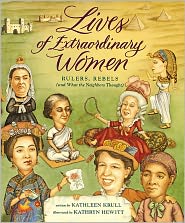March 27 - Today's post provided by Waking Brain Cells
Nonfiction about Amazing Women
Children’s nonfiction is a great place to take a look at women who should be part of our history books but so often are overlooked and forgotten. Here are four books that each child, girl or boy, should know about to have a more complete understanding of the role of women in history and today:
 Almost Astronauts by Tanya Lee Stone
Almost Astronauts by Tanya Lee StonePublished in 2009, Stone’s book about the Mercury 13 women won the 2010 Sibert Medal and was also nominated for a YALSA Award for Excellence in Nonfiction for Young Adults. It is the story of women who tried to be astronauts before females were allowed in the NASA program. It is the story of women denied their right to be astronauts despite exceeding the mastery of the men in the program. It is the story of women of strength and character who have been forgotten by history.
Amelia to Zora: Twenty-Six Women Who Changed the World by Cynthia Chin-Lee, illustrated by Megan Halsey and Sean Addy
This 2005 title celebrates 26 women who changed the world. Appropriate for younger children than the other books on this list, this picture book gives short pieces of information on these amazing women. Included in the title are Amelia Earhart, Frida Kahlo, Nawal El Sadaarvi, and Zora Neale Hurston. The women represent a wide range of ethnicities and each has a quote included as well. The illustrations add a beauty to the book, celebrating the women in a moving way.
 Lives of Extraordinary Women: Rulers, Rebels (and What the Neighbors Thought) by Kathleen Krull, illustrated by Kathryn Hewitt.
Lives of Extraordinary Women: Rulers, Rebels (and What the Neighbors Thought) by Kathleen Krull, illustrated by Kathryn Hewitt.Published in 2000, Krull’s book about 20 extraordinary women in history is part of her very entertaining series on historical figures. This book celebrates women like Cleopatra, Harriet Tubman and Eleanor Roosevelt. Nicely, it includes women around the world. If you like humor mixed with your nonfiction, Krull is the author for you!
Published in 2004, this book is a visually powerful history of the fight for women’s right to vote in the United States. The book follows the evolution of the suffrage movement, telling the story of the courageous women who fought for the right to vote against all odds. It is a story of courage despite imprisonment, of the strength to protest despite derision, and of the passion for voting that so many of us have forgotten today. These are women who should be listed with other heroes in our country and whom are often forgotten.
Editor's Note:Authors Tanya Lee Stone, Kathleen Krull and Ann Bausum have each graciously contributed posts here this month.
Waking Brain Cells is the new online home of longtime blogger, Tasha Saecker. If you have been wondering about her new location, wonder no more - you can find her at Waking Brain Cells.
























